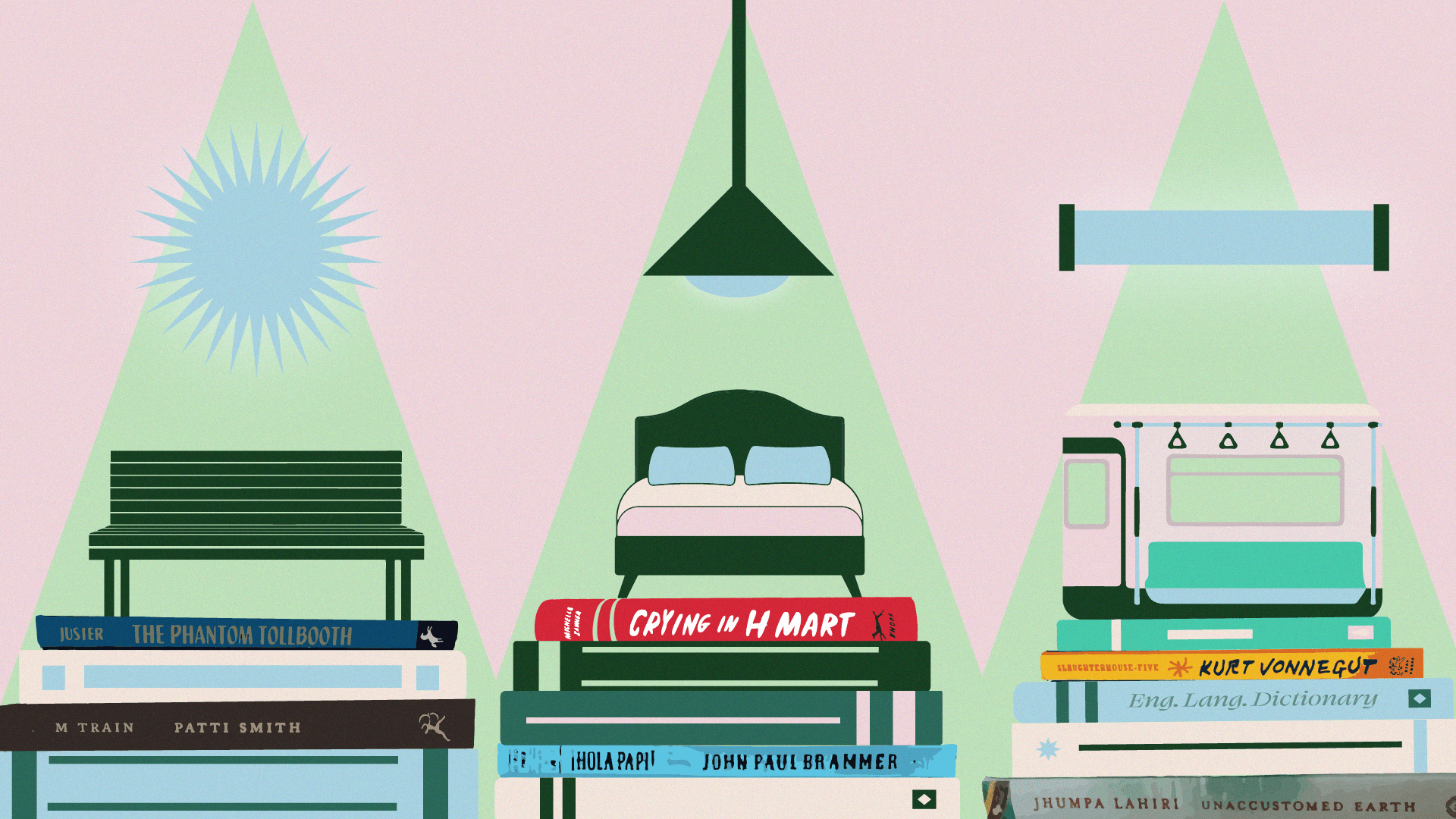
The Renewed Pleasure of Reading as a College Graduate
Academia can distract from a love for reading. Here’s how new graduates got it back.
Content Warning: This essay briefly mentions suicide. If you or a loved one needs immediate care, the Suicide and Crisis Hotline at 1-800-273-8255 remains active 24/7.
In fifth grade, my dad grabbed The Phantom Tollbooth from my sister’s bookshelf and told me, “It’s time you start reading.”
So I did, but I wasn’t really happy about doing so. Unlike my sister, I struggled to immerse myself in books because I couldn’t keep up with the habit and pressure of reading every day. My annoyance and dissatisfaction with reading grew with each passing book I took from her collection, but it made my dad happy to see me pick up a book instead of the remote control. So I stuck to it.
Though I read a few advanced books for my elementary-school age like The Catcher in the Rye, Slaughterhouse Five, and 1984, I worried that the deeper meaning of those novels would slip through my grasp — especially when I got bored. I always had difficulty maintaining my focus when I read books as a pre-teen. This became more laborious to do as I progressed through academia, where reading was less about the stories themselves, but about related tasks I had to complete for school. While I didn’t give up on reading, it was a chore rather than a pastime for almost a decade. But like many young people, I fell in love with reading after college.
One month after graduation, I found myself dealing with intense panic attacks and chest pains that prevented me from many routine activities. Of these two symptoms, the one that was difficult to deal with the most were the chest pains I’d feel come up during random moments of my day such as on my walks or while cooking dinner. With the help of my therapist, I discovered I was experiencing physical manifestations of my anxiety.
Unfortunately, these symptoms rendered me unable to socialize with my friends or leave my apartment for much of last fall. The thought of interacting with the world scared me. So I shuttered myself in my apartment and decided to give reading books another go. I thought, “This time I’ll be in control of what, when, and how I read.”
As I plucked Unaccustomed Earth by Jhumpa Lahiri and M Train by Patti Smith from my collection of unread books, I noticed that reading wasn’t as terrible as I once thought it was. What made it so daunting had nothing to do with me, but the way I was taught to read when I was younger, particularly in high school. Assigned readings always provoked dread, due to the activities my teachers made my classmates and I do to “absorb” the literature. Tasks like annotating a certain amount of pages in our books or writing one-page analyses of each chapter felt like they took away from the pleasure of reading.
Rather than opening myself up to a wonderful relationship to reading, I shut out my desires and simply did the assignments as meticulously as possible to get the best grades I could. As I began conducting interviews with other college graduates for this piece, I found that I wasn’t the only one that felt this way.
Julianna O’Malley, a 22-year-old University of Oregon graduate, said that although she grew up with a penchant for immersing herself in the stories she read, the pressure of assigned literature coupled with specific reading tasks changed her attitude towards her favorite hobby.
“I felt like [annotating] took me out of the reading experience,” O’Malley said. “I annotated for the sake of points rather than for the sake of getting anything out of the reading.”
But it wasn’t always this way. O’Malley remembers immediately falling in love with reading as a child. She would read in the dark, even though she knew it would strain her eyes. Every year, she and her friends attended the Los Angeles Times Festival of Books. At one point, her mom insisted on screening the books O’Malley read to make sure they were age-appropriate. This practice ended quickly, because her mom couldn’t keep pace with her reading rate.
Her ability to consume multiple books per week gave O’Malley a sense of validation, but between high school assignments and the demands of college courses, her passion for reading dwindled. And though O’Malley didn’t seriously pick up a book to read for pleasure until after graduation, a more serious life change led her to reassess her relationship to reading.
In the fall of 2021, O’Malley’s stepdad was diagnosed with cancer. Suddenly, she found herself spending more time at home with her family and together they created a new reading routine. Now, O’Malley and her parents wake up around 7 a.m. every morning to read for two hours before starting their day. It’s an opportunity for them to be present and bond with one another. It also eased O’Malley back into reading after college.
“Initially, I would chat with my parents, play around on my phone, or do a crossword puzzle,” she said. “But then I started reading just for the heck of it because I needed something to do during our family time.”
Similarly, after life-altering events due to COVID-19 impacted my family in 2021 — such as the deaths of mi tíos Gil and Lalo — I thought about the importance of what my newfound relationship with reading meant. At the time, the only way to deal with the grief and pain I felt was to turn to books and read an author’s thoughts and words that resembled what I was experiencing.
In the fall of 2021, I picked up Crying in H Mart by Michelle Zauner, an extraordinary memoir about Zauner’s relationship with her mother and how remembering her mother’s vigorous love for Korean food helped her cope with her passing. Though I wasn’t able to articulate my grief with words, Zauner’s memoir inspired me to comb through my memories of visiting my family in Mexico City and reminisce about the particular habits of my uncles that would help me keep them alive.
I voraciously read that book, feeling seen in each page that discussed the complexities of grieving, the feeling of guilt, and the things that are done to remember family members who have passed. As it turned out, reading Zauner’s memoir gave me the ability to work through the heartache and sorrow that is losing loved ones. But it also solidified my love for personal essay books and memoirs, a genre I had no idea I’d connect deeply with.
Though I’m a little bummed I didn’t find this delight until now, I recognize that these kinds of discoveries — such as becoming acquainted with your favorite genre — happen on their own time and in their own way.
Alejandra Arévalo, a 22-year-old New York University graduate, found that she enjoys reading ethnographies during her downtime, a discovery she made while studying sociology in college. Her readings discussed race, gender, and gentrification, all topics that she was particularly interested in. But the pressure of getting the readings done for class, especially when ethnographies touched on difficult subjects like the impacts of the prison system on Black youth, didn’t allow her to reflect and process the content on her own time, she said.
Arévalo felt that at times, it was hard to digest tough content brought up in her reading and mentally prepare for class. She maintains that her professors should have included trigger warnings in their curriculum so her peers could take the necessary space and time they needed to process the readings in advance — especially when the content discussed issues that would impact students of color.
“Sometimes the thing that we’d discuss was really triggering and it wasn’t fair for professors to do that because they’d put us in such an uncomfortable situation,” Arévalo said.
Since graduating college, Arévalo’s built a strong relationship with reading on her own terms. She says that when she encounters ethnographies that discuss heavy subjects or something that she’d rather not read at the moment, she sets it aside and takes time away from reading to decompress.
“I can intentionally engage with the content I’m reading like remembering the names of characters or other tiny details,” Arévalo said. “I forgot how fun it can be to read ethnographies.”
In the year since I began reading again, I’ve been conscious about the personal essays I want to engage with. I know that there’s no way to include a trigger warning on every essay an author has included in their memoir but when I notice that they touch on a difficult subject matter in their literature, I space out how much I’ll read for the day.
I practiced this well when I read ¡Hola Papi! by John Paul Brammer last year in October. Brammer, the genius behind the incredibly popular advice column “¡Hola Papi!,” stylized his essays to look like he’s responding to a reader’s question. Each one discusses topics such as coping with childhood trauma, dealing with years spent in the closet, growing up biracial and more.
Most of these stories he recounted were lighthearted and warm with a flare of comedy added to them. But every now and then, an essay would gut punch me. I remember reading an essay that discussed his experience being bullied in the eighth grade and how the teasing was so homophobic that it reached a point where he contemplated suicide. The details in this essay were rather grim that I cried every time I read more of it.
I decided that maybe I shouldn’t read the essay all in one go. Instead, I read a page or two a day and even skipped the essay to read others and come back to it when I felt prepared to tackle the rest.
That’s when I realized that being a “good” reader to me isn’t about how much I read all at once but about whether I’m reading at a comfortable pace and grasping what the author is trying to convey in their book. Even if it took me longer to finish that essay than I had anticipated, I’m grateful that I took my time.
Growing up, the specific phrase “take your time” when used to describe reading wasn’t something I believed in. As a young pre-teen, I felt pressured to read my books all in one go rather than space it out across a couple of weeks. I felt like I failed at reading if I didn’t do that. Looking back on this, I realize how ridiculous that sounds. I know now that “time” shouldn’t have meant as much to me, especially since it prevented me from discovering what kind of reader I wanted to be.
Alejandro Villa Vasquez, a 23-year-old New York University graduate, believes that “voraciously consuming books isn’t the be all, end all” when it comes to reading for him. At the time of our interview, Vasquez shared that he had recently challenged himself to read a novel longer than 400 pages. He noted that though it was taking him a bit longer to finish the novel (around two months or so), what mattered was that he reached his milestone of reading a longer book.
“I know plenty of people, especially going to NYU, who read a lot and probably read 485-page novels for breakfast,” Vasquez said. “But me? I’m just focusing on my goal to improve my stamina as a reader.”
To be clear, this is in no way a slight against fast-readers. Rather, this decision to pace himself while reading has to do with the milestones he wants to reach and what he describes as “making up for lost time.” Vasquez recalls the literary canon he encountered throughout middle school and high school containing nothing that reflected his Colombian identity nor anything written by Latine authors. As expected, most books he read were authored by white people.
And though the literature he read diversified in college, the emphasis remained largely on reading white authors. Now, as he enters his postgraduate years, Vasquez has decided to intentionally surround himself with Latine literature not only because he wants to but also because it’s what he needs to support his goal of becoming a well respected non-fiction writer and journalist.
“Reading Latine literature is what I want,” Vasquez said. “It’s what I need for the kind of person I want to become and the kind of writer that I want to be.”
Listening to Vasquez discuss his purpose for reading made me reflect on my journey. Back in the fall of 2021, I read to ease my anxiety and support my mental health. But my purpose regarding this hobby has since changed. Recently, I discovered that I want to be an essayist of sorts (I know how very original). My reading list — which had no structure whatsoever — has been reorganized into two sections: “Must read to become a better writer!!” and “Can it wait? Ehh…I kinda wanna read it but okay yes, it can.”
The former is solely dedicated to essays and memoirs that I believe will help me find my voice as an essayist. The latter is for recommendations and books I’ve impulsively bought at the bookstore. Any reading I do is always for pleasure but having a list filled to the brim with essay books has helped me figure out what stories I’d like to write about some day and the structure, tone and style that would best capture my writing.
It took me a long 14 years and a will they, won’t they relationship with reading to find my groove and purpose as to why this activity is important to me. My journey has brought me to a point in my life where I’ve never been more confident about what I want to write and why.
While interviewing other college graduates about their experiences, I was captivated by everyone’s purpose for falling back in love with reading. Even though each story is connected by a common thread, no two people read for the same reasons.
Dyanna Castaneda, a 22-year-old graduate from UC Riverside, has been using her bookstagram account, @dyannaslibrary, to motivate herself to pen her thoughts down so that she can come back to it later and remember how she felt about a particular novel or book. She says it’s her “personal assignment” that allows her to enjoy her reading process.
“I’ve read a bunch of books throughout my life and have forgotten how I felt about them or forgot what went on in them,” Castaneda said. “So my bookstagram is like a personal archive for me.”
Castaneda’s bookstagram has also helped her feel less pressured to read books from a certain genre and stick to it. As opposed to reading similar literature assigned by her professors while completing her English minor (which she enjoyed a lot!), Castaneda cultivates her bookstagram space to look however she wants it to. From short stories to sci-fi to fiction, her account demonstrates the kind of reader she is — one that reads “whatever comes across her way.”
Now that she’s fallen back into a rhythm of reading, Castaneda wants to become more knowledgeable about different genres that she hasn’t read before — as well as herself.
“Something I’m looking forward to is reconnecting with myself,” Castaneda said. “It’s a great exercise for me to only focus on one thing. Reading is just very grounding.”
There’s nothing quite like perusing through my bookshelf, running my fingers among the spines of my books, and selecting my next read. Never in my life did I think that reading would give me the ability to slow down and be present, but it has and I’m so grateful for that.
When I have days where I’m anxious about my never ending to-do lists or days that are tougher to get through, I close my eyes and imagine myself sprawled across my bed, relaxing with a book in my hand.

